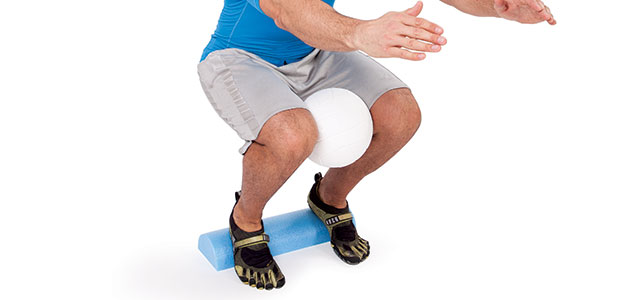
Runner\’s Knee. Arthritis. Bursitis. You don\’t have to be an elite athlete to be affected by knee pain. Although debilitating, certain exercise techniques can provide welcome relief from this common complaint. Learn more about injury prevention and treatment to keep your most precious joints moving smoothly.
Forget the human condition—knee pain is the one unifying force that most of us have experienced on some level. A sprain, a twist, a dislocation, a bruise; certain acute injuries are unavoidable. Many chronic injuries are avoidable, however, but there’s no need to put up with persistent pain.
For the love of knees
If you’ve ever been injured, chances are you’ve heard of rehabilitation or rehab: repairing and strengthening an injured muscle, joint, or bone, and nursing it back to health. For a few decades now, athletic trainers and strength and condition coaches of elite-level athletes have been employing something called “prehab.”
Prehab exercises strengthen and stretch the muscles that support the joints in an effort to avoid injury altogether. You may not be a professional athlete, but your legs are the key to your mobility, and your knee health is paramount to an active, healthy lifestyle.
The bane of your existence
How many times have sore knees or the threat of pain stopped you from participating? You wake up, they’re sore. You go to sleep, they’re sore. You sit, you stand, they’re sore—but they don’t have to be. Many knee problems are caused by weakness or tightness in surrounding muscles, which means they can be fixed.
Other problems, such as bursitis (inflamed fluid-filled pads at the joint) and tendinitis (inflamed tendons from overuse) can be healed with sufficient rest and inflammation control through the use of ice and anti-inflammatories.
Go low impact
If you suffer from tendinitis, osteoarthritis, or patellofemoral pain syndrome (characterized by a dull ache under the kneecap when squatting or walking down stairs), avoid exercises or activities that involve jumping, hopping, running, or sporadic and random lateral movement. Instead, opt for low-impact activities on predictable surfaces.
Warm up properly
To properly rehabilitate your knees, you will experience some discomfort when doing exercises. Make sure to have a good warm-up, such as a five- or 10-minute walk, to get synovial fluid flowing in your joints, and perform all exercises with control and appropriate resistance. Afterward apply ice to reduce swelling.
Get support
If you’ve spent a lifetime abusing your knees, you may be looking for a little added support. While surgery and expensive braces may ultimately be the answer, it’s possible that supplements may help alleviate some discomfort. Visit your local health and nutrition store or a natural health practitioner for recommendations.
A quick lesson in leg anatomy
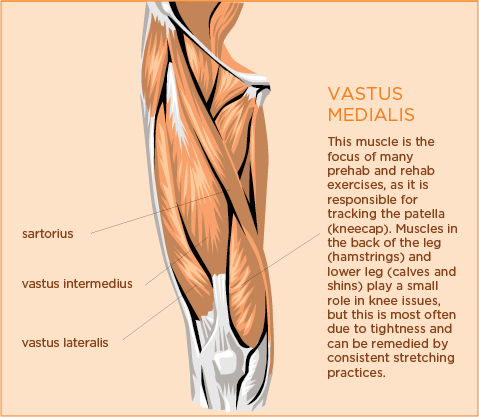
When talking about knee strengthening exercises and muscles that affect knee movement health, the focus is on the four muscles of the quadriceps:
| Muscle | Location | Function | Typical movement |
| sartorius | runs across the thigh, from the outside of the hip to the inside of the knee |
|
kicking a soccer ball with the inside of the foot |
| vastus intermedius | muscle in the top middle of the thigh |
|
walking |
| vastus lateralis | big muscle on the outside of the thigh |
|
getting up from a squat position |
| vastus medialis | big muscle on the inside of the thigh |
|
walking |
Need to succeed
Whether you’re hoping to avoid future knee injuries or currently suffer from knee pain and want to be rid of it, consistently performing the following exercises should start to provide noticeable relief.
Complete 3 sets of each exercise for 20 repetitions, or as directed. This circuit may be done at home and is performed every other day to allow muscles to recover. It’s best to do this workout wearing shorts or clothing that lets you see your leg muscles clearly.
Drop Squat
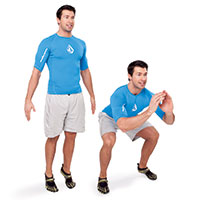 Muscles targeted: vastus medialis, gluteus medius, gluteus maximus, gastrocnemius
Muscles targeted: vastus medialis, gluteus medius, gluteus maximus, gastrocnemius
- Begin by standing on your toes with your feet together and your arms relaxed by your sides.
- As you hop your feet out to shoulder-width apart, drop down into a seated position, allowing your arms to swing forward while keeping your weight in your heels.
- As you drop down to chair seat height, be sure to have your knees and toes turn outward at a 45-degree angle.
- Pop up to starting position, ensuring your knees still track outward over your toes.
- You should finish on your toes as tall as possible.
Neuromuscular Facilitation
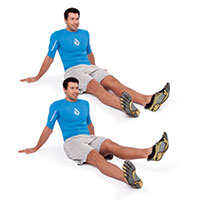 Muscles targeted: vastus medialis
Muscles targeted: vastus medialis
- Sit on the ground with legs outstretched in front of you, feet roughly hip-width apart.
- While actively pointing toes toward you, rotate them out to the sides as far as possible, keeping your heels on the ground.
- With your left side, flex your inner thigh muscle as tightly as possible and lift your entire leg off the ground.
- After a brief pause, lower your left leg and relax the muscle.
- Do 20 lifts and then switch sides for 20 more lifts.
Note: it is important to contract your inner thigh muscle before your outer thigh muscle, as this exercise trains the timing of muscular activation.
Single-leg High Squat
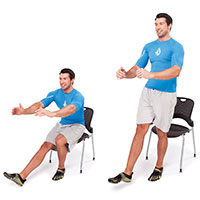 Muscles targeted: vastus medialis, vastus lateralis, vastus intermedius, sartorius, gluteus medius
Muscles targeted: vastus medialis, vastus lateralis, vastus intermedius, sartorius, gluteus medius
- Use a chair with a seat height 2 in (5 cm) above the back of your knee.
- With your back to the chair seat, stand on your left foot with your toe pointed forward and your right foot raised 1 to 2 in (2.5 to 5 cm) off the ground in front of you.
- While maintaining a tall upper body, slowly lower your bum to lightly touch the top of the seat. While you may use your arms to assist at first, the goal is to be hands free!
- When you feel the touch, slowly stand back up to starting position, making sure to push your hips all the way forward.
- It’s critical to watch your knee track directly over your toes while lowering and raising yourself, being careful not to let your knee cave inward.
- Perform 20 reps on the left leg and then 20 on the right.
Note: to adjust difficulty, raise or lower seat height.
Standing Quadricep Extensions
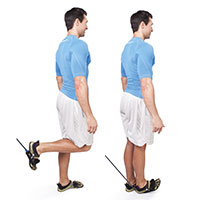 Muscles targeted: vastus lateralis, vastus medialis, vastus intermedius, sartorius
Muscles targeted: vastus lateralis, vastus medialis, vastus intermedius, sartorius
- Place one end of a resistance band on the other side of the top of a door and close the door. The resistance band handle will be anchored on the other side.
- Loop the handle of the resistance band around the arch of your right foot, adjusting it so that the tubing extends under your foot.
- Situate yourself about 6 1/2 to 10 ft (2 to 3 m) from the door, facing the opposite direction while holding onto a chair in front of you for balance.
- Keeping your left foot on the ground and your knees touching, raise your right heel toward your glutes. Ensuring your inside quadricep muscle fires first, slowly return your foot as if kicking a ball, so that your leg finishes completely straight, flexing your muscle as much as possible.
- Do 20 reps on your right side and then perform 20 on the left.
Progression: stand farther from the door to increase the tension.
Ball Squeeze Toe Squat
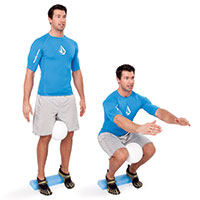 Muscles targeted: vastus medialis, vastus lateralis, vastus intermedius
Muscles targeted: vastus medialis, vastus lateralis, vastus intermedius
- Find a slightly underinflated ball roughly the size of a soccer ball.
- Place the ball between your legs, slightly above your knees.
- Squeeze your knees together as tightly as possible and align your feet so that if you look down, your toes are directly below your knees.
- When you have found the proper width, put a 1 1/2 to 2 in (4 to 5 cm) high object under each of your heels. A sturdy book or a door jamb will do nicely!
- While squeezing the ball tightly and keeping toes pointed straight forward, squat down to chair seat height, while maintaining equal weight distribution throughout your feet.
- Still squeezing the ball, stand all the way up to starting position.
Progression: add weight by holding a dumbbell at your chest.
Rock and Roller
 Muscles targeted: tensor fasciae latae, iliotibial band (IT band), sartorius
Muscles targeted: tensor fasciae latae, iliotibial band (IT band), sartorius
- Use a foam roller or a tennis ball.
- Lie on your side on top of the roller so that it’s lined up horizontal to your body.
- Situate yourself so that the roller is putting direct pressure on your tensor fasciae latae, (located below and behind your hip bone); it will be tender.
- Lie on the roller, applying as much weight as you can bear while still relaxing your leg muscles.
- After holding for 60 seconds twice, slowly roll your body, allowing the roller to go all the way down the side of your leg to your knee.
- Carefully roll it back up your leg to your hip.
- Repeat this 15 times.
- Turn over so you are face down on the floor. Move your body to the side of the roller and deliberately roll from your hip down to your knee and back again 15 more times.
- Do the same circuit with your other leg.




































